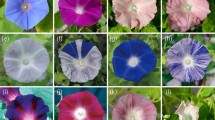Abstract
The white flowering mutant W48 of Petunia hybrida is dominant for the hydroxylation gene Hf1 and homozygous recessive for the hydroxylation gene Ht1 and the anthocyanin gene An1. Flower buds of this mutant accumulate dihydrokaempferol-glucosides. Thus the effect of Hf1 being dominant is not the hydroxylation of the C15 skeleton, as is the case in mutants that are able to synthesize anthocyanins. This can be explained either by a feed-back inhibition of the hydroxylation by small amounts of dihydromyricetin (glucosides), or by a controlling effect of the gene An1 on the expression of Hf1. However, the white flowering mutant W58, which is homozygous recessive for the gene An6 and dominant for Hf1, accumulates dihydromyricetin (glucosides). This excludes a possible feed-back inhibition by dihydromyricetin and we conclude that An1 controls the expression of Hf1. Feeding of radioactive malonic acid to isolated flower limbs of mutants able to synthesize anthocyanins, leads to the incorporation of radioactivity into dihydrokaempferol (glucosides) and dihydroquercetin (glucosides). These results show that glucosylation of dihydroflavonols is a normal event in anthocyanin biosynthesis and is not induced by an inhibition of anthocyanin synthesis.
Similar content being viewed by others
References
Forkmann, G. (1980) The B-ring hydroxylation pattern of intermediates of anthocyanin synthesis in pelargonidin and cyanidin producing lines of Matthiola incana. Plant 140, 157–161
Kho, K.F.F., Bennink, G.J.H., Wiering, H. (1975) Anthocyanin synthesis in a white flowering mutant of Petunia hybrida by a complementation technique. Planta 127, 271–279
Kho, K.F.F., Bolsman-Louwen, A.C., Vuik, J.C., Bennink, G.J.H. (1977) Anthocyanin synthesis in a white flowering mutant of Petunia hybrida II. Accumulation of dihydroflavonol intermediates in white flowering mutants: uptake of intermediates in isolated corollas and conversion into anthocyanins. Planta 135, 109–118
Mabry, T.J., Markham, K.R., Thomas, M.B. (1970) The systematic identification of flavonoids. Springer, Berlin Heidelberg New York
Tabak, A.J.H., Meyer, H., Bennink, G.J.H. (1978) Modification of the B-ring during flavonoid synthesis in Petunia hybrida. Introduction of the 3′-hydroxyl group regulated by the gene Ht1. Planta 139, 67–71
Wiering, H. (1974) Genetics of flower colour in Petunia hybrida Hort. Gene Phaenen 17, 117–134
Wiering, H., de Vlaming, P., Cornu, A. and Maizonnier, D. (1979) Petunia genetics. I. — List of genes. Ann. Amélior. Plant 29, 611–622
Author information
Authors and Affiliations
Rights and permissions
About this article
Cite this article
Tabak, A.J.H., Schram, A.W. & Bennink, G.J.H. Modification of the B-ring during flavonoid synthesis in Petunia hybrida: Effect of the hydroxylation gene Hf1 on dihydroflavonol intermediates. Planta 153, 462–465 (1981). https://doi.org/10.1007/BF00394987
Received:
Accepted:
Issue Date:
DOI: https://doi.org/10.1007/BF00394987




